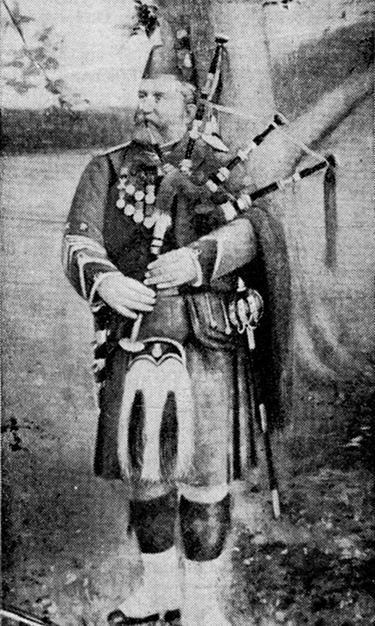We continue with our feature on Macdougall of Aberfeldy and the feature which appeared in the People’s Journal newspaper of November 4, 1893. It is by their ‘Lady Correspondent’ and is headlined ‘An Interview with the Queen’s Bagpipe-Maker’. This is a period piece of writing and the author is clearly no piper. Would that we could get our hands on some of the sets mentioned. There is relevant information on the ivory Macdougall used.
Mr Macdougall was inconsolable that he did not happen to be making pipes the day I was there. He had just finished repairing a set of bagpipes belonging to the Duke of Richmond and Gordon which lay in a box on the table. They were ‘upholstered’, so to speak, in Gordon tartan, the old set, and sported a cataract of ribbons no less than five yards of which is necessary to dress the drones and chanter properly.
He was preparing the reeds, an unseen but most important part of the mechanism as by their means the air is modulated. These are made of the best Spanish cane, bundles of which stood about in the corners. The reed is quite a small affair, about the size of your finger, one end flattened until the edges almost meet, and kept in position by a stout ligature, very neatly attached. These reeds have to be renewed yearly or oftener. It depends on the player and the climate.
I asked how long the sheepskin bag of a set would last. ‘It depends entirely on the player,’ was the reply. ‘Some will make them go two years, others six months. It depends on the man’s breath. A player with an acid stomach will wear out his bag twice as quick as will a healthy man. I noticed this very much when I was in the Army.’
Perhaps you have never been in the near neighbourhood of a set of pipes – near enough, that is, to note their formation closely. I know I never was before. Well they are composed of the bag, which is generally of sheepskin, covered either with green baize or tartan. Then there is starting from this the cluster of pipes which looks so confusing, viz, the chanter which produces the melody, which is pierced with eight holes [sic], and has an imperfect scale. Of the three others called drones, two are in unison with the lowest A of the chanter and the third and longest an octave lower [sic]. It is the drones, of course, which are responsible for the droning or humming noise which is such a characteristic of the instrument.
It is on the chanter and the drones that the decorative art of the maker is most expended. Mr Macdougall made a beautiful set of pipes for use in Her Majesty’s household, which were exhibited at the Edinburgh Exhibition of 1888. These were entirely silver-mounted, and artistically chased with a design of Scottish thistles. He has also made pipes for use in the households of TRH [Their Royal Highnesses] the Prince of Wales and Alfred Duke of Coburg, the Duke of Fife, Lord Huntly and Breadalbane, Earl of Dunmore and many others. One of the most beautiful sets of pipes Mr Macdougall ever turned out was presented to the Caledonian Company of the Natal Royal Rifles by Sir Donald Currie MP.
[wds id=”6″]
Ebony, I was told, is the wood most commonly employed, as it takes a fine polish, and is very hard. For use in foreign countries, however, a brown wood called cocoa is best, as there is a native oil in the wood which prevents its cracking with the heat. For the mouthpiece ivory is used and I asked Mr Macdougall where he got it. ‘In Dundee’, he said. ‘I come down when the whalers come in. It’s sea ivory I use; the horns of the walrus, the husks of the sea lion and the blade of the sword fish. Here is a whole set of drones and chanter cut out of a huge narwhal horn; but it’s not a success,’ he added pointing to the streaks and chips which disfigured it. ‘Would vegetable ivory not do?’ I enquired, but was told it was too brittle.
Bone is occasionally used for the cheaper classes of pipes, but it quickly turns yellow. Peat reek too, soon spoils the colour of ivory exposed to its influence. You can imagine how tenderly the Highland shepherd or ghillie will wrap up his cherished pipes in his best plaid and commit them to the keeping of the big kist [chest] to preserve them from the pungent and penetrating reek.
Mr Macdougall turns the wood and ivory that he needs at a bench fitted with lathes of different sizes, and furnished with a bewildering variety of tools, gauges and planes and drills. ‘What do bagpipes cost?’ I bethought me to inquire after I had heard all about their components.
‘Sets can be got from 50s [shillings] up to £50 – according to the value of the mounting,’ was the reply. ‘The Queen’s set cost £60, but then there was a lot of silver on them. Practice chanters can be got from 5 shillings and 6 pence upwards.’
The beginner anxious to learn the pipes does not start off at once on the full set. To do so would be quite hopeless. He gets a practice chanter and learns the fingering, and that once mastered he is entrusted with the real instrument – at a safe distance, let us hope, from human habitation. For if the practising piano be irritating and the amateur violin maddening, what shall be the effect of the bagpipe in unskillful hands? The imagination refuses to picture it!

 Be the Best You can Be … World Class Tuition at the New England Pipe & Drum Academy … It Does Not Get Any Better than This
Be the Best You can Be … World Class Tuition at the New England Pipe & Drum Academy … It Does Not Get Any Better than This
Leaving these commercial details, I found Mr Macdougall eloquent on the poetical aspect of his art. He knows all about the genesis and development of the pipes, and brought for my inspection a set of beautiful old English bagpipes, very slender and pretty, a chamber instrument with thin but pleasing tone. On this he played a piobaireachd, explaining as he did so the character of the music and the development of the air.
Next he produced a dainty little set of Irish pipes which are not inflated in the ordinary way by the mouth, but blown by means of a tiny pair of bellows which the player straps to his right arm and works as he plays. It suggested the hurdy-gurdy too much but the tone was mellow and pleasing. The Irish and English pipes are elegant little instruments but mere toys beside the great Highland or military bagpipes, whose wild scream has so often led an army into battle, rallied breaking ranks, brought cheer to fainting hearts and sung above the victorious warrior in Pibroch or in Coronach. Rudyard Kipling has written the paean of the drum in his ‘Drummer of the Fore and Aft’. Who will do as much for the piper, the hero of a hundred fights?
I don’t know anything sweeter than on a summer gloaming to listen to the plaintive music of the pipes as it steals down the glen. I don’t know a more moving sight in the world to a Scottish eye than a Highland regiment with ‘bonnet, feather an’ a’, marching to the martial music of the Gael, the pipers in front ‘pride in their port, defiance in their eye’ and every heart tingling to the pibroch. The pipes, indeed, in skilful hands can be made to answer to every gradation of feeling, as the subscription to an old German print has it:
He blows his bag-pipe soft or strong,
Or high or low, to hymn or song,
Or shrill lament, or solemn groan,
Or dance, or reel, or sad o-hone!
Or ballad gay, or well-a-day,
To all he gives due melody.
I am afraid that the bagpipes have all through this article rather run off with the bagpipe-maker, but I know no one will pardon this more readily than the genial Royal bagpipe-maker himself whose portrait appears at the head of this article.
• Some readers may not be aware of the revered status of MacDougall of Aberfeldy pipes. Along with vintage sets of Lawrie and Henderson, they are among the most sought after of instruments. Characterised by a steady, if slightly muted tone, they are less popular now than hitherto. Nevertheless those who own these instruments seldom part with them. We would be interested to hear from anyone who has MacDougall pipes. Read Part 1 of this article here.
[wds id=”10″]
















Recent Comments